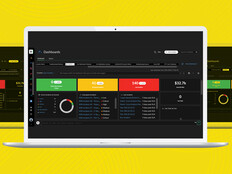The 5 Biggest Higher Education Tech Trends in 2016
This year was ripe for higher ed innovation. Just take a look at coverage from EDUCAUSE, which highlights the trends that have flourished in 2016. Colleges across the country have transformed learning spaces, advanced their libraries technologically, and bolstered campus security.
Along with increases in cloud adoption, the rise of virtual reality and stronger cybersecurity programs, here’s a look back at the biggest higher ed tech trends of 2016.
SIGN UP: Get more news from the EdTech newsletter in your inbox every two weeks!
1. Understanding the Power of Data
This year, data has been a huge factor for a lot of industries, higher education included. Tech decision-makers on a number of campuses have started to examine where data might fit into daily operations.
Data has also powered some significant positive changes across campuses. At Middle Tennessee State University, predictive analytics fueled by student data have helped advisors to bring their retention rate up to 95 percent.
University of Maryland University College has made analytics an integral part of their operations, and because of it they could reduce marketing spending by 20 percent.
It turns out students actually don’t mind that universities are collecting more information on them than ever before. Ninety-eight percent of student respondents to an Ellucian survey said they want their schools to use their personal information to improve the overall college experience.
A KPMG survey found that 41 percent of universities were using data for forecasting and predictive analytics. This number is only expected to rise next year, with EDUCAUSE naming data-informed decision-making and predictive analytics to improve student success to their 2017 Top IT Issues list.
2. Protecting Colleges from Growing Cybersecurity Threats
Known for their caches of research data and personal information, higher education institutions were the number two target for cyberattacks in 2016. So this year, colleges stepped it up in terms of cybersecurity tactics.
With many finding that threats are introduced by users more than they might think, universities are working to create better security habits. In January, the University of Dayton kicked off a yearlong “cyber mindfulness” campaign of proactive activities like phishing tests and incentives for reaching security goals.
Cybersecurity will also be top of mind for 2017, as EDUCAUSE named security as its top IT issue for the coming year.
3. Seeing the Valuable Potential for Virtual Reality
From improved headsets by Oculus and Google to the launch of several “experiences,” virtual reality made a lot of strides this year. So many, in fact, that Forbes forecasted next year to be the year for VR.
But what about the implications for higher ed? Well, some small steps were made for VR at universities. Indiana University Bloomington is working toward creating a shared VR workspace for students in all disciplines.
Because of its immersive capabilities, the promise of VR for medical students is pretty huge. In fact, the University of Illinois at Chicago is already using VR as a way for students to put themselves in the shoes of elderly patients.
4. Creating Robust Networks for Even More Devices
A ubiquitous and powerful Wi–Fi network is now so important for students, that colleges like the University of California, Irvine are prepping for students that haven’t even arrived yet. As students bring more connected devices to campus — EDUCAUSE estimates 61 percent will have at least two — it has gotten even harder for universities to provide the bandwidth needed.
With a combination of network optimization, creative IT policies, and research to prepare for the incoming Internet of Things, universities are being proactive about creating the networks of the future.
5. Increasing Utilization of Cloud Services
Cloud adoption is growing quickly in the higher education sector, and 81 percent of IT leaders in higher ed say they will be spending even more money on cloud services next year.
Cloud has made it possible for colleges to have scalable data centers, more efficient software rollouts, and even more accessible labs for science classes.
The next few years will see even more growth to the cloud. A MeriTalk survey found that 39 percent of applications at college today are cloud-based and by 2021 that number is expected to climb to 62 percent.









